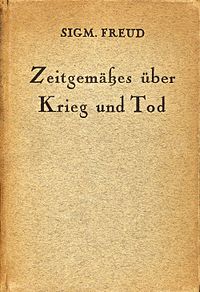Thoughts for the Times on War and Death
 The German edition | |
| Author | Sigmund Freud |
|---|---|
| Original title | Zeitgemäßes über Krieg und Tod |
| Language | German |
Thoughts for the Time of War and Death (German: Zeitgemäßes über Krieg und Tod) is a set of twin essays written by Sigmund Freud in 1915, six months after the outbreak of World War I. The essays express discontent and disillusionment with human nature and human society in the aftermath of the hostilities; and generated much interest among lay readers of Freud.[1]
Disillusionment[edit]
The first essay addressed the widespread disillusionment brought on by the collapse of the Pax Britannica of the preceding century[2]—what Freud called "the common civilization of peacetime."[3]
Discounting death[edit]
The second essay addressed what Freud called the peacetime 'protection racket' whereby the inevitability of death was expunged from civilized mentality.[4] Building on the second essay of Totem and Taboo,[5] Freud argued that such an attitude left civilians in particular unprepared for the stark horror of industrial-scale death in the Great War.[6]
Influence[edit]
Freud's account of the centrality of loss in culture has been seen as seminal for his later work, Civilization and its Discontents.[7]
Translations[edit]
The Standard Edition of the Complete Psychological Works of Sigmund Freud, translated by James Strachey, titles the work Thoughts for the Times on War and Death, titles the first essay "The Disillusionment of the War" and titles the second essay "Our Attitude Towards Death".[8]
The Authorized English Translation, published by Moffat, Yard and Company, New York, 1918, translated by Dr. A. A. Brill and Alfred B. Kuttner, titles the work Reflections on War and Death, titles the first essay "The Disappointments of War" and titles the second essay "Our Attitude Towards Death".[9]
See also[edit]
References[edit]
- ^ Ernest Jones, The Life and Works of Sigmund Freud (Penguin 1964) p. 436
- ^ Stephen Gill, Power and Resistance in the New World Order (2003) p. 37
- ^ Sigmund Freud, Civilization, Society and Religion (PFL 12) p. 65
- ^ Adam Phillips, On Flirtation (1994) p. xx
- ^ Angela Richards, Note, in Sigmund Freud, Civilization, Society and Religion (PFL 12) p. 59
- ^ Peter Gay, Sigmund Freud: A Life for Our Time (1989), pp. 356-7
- ^ Abraham Drassinower, Freud's Theory of Culture: Eros, Loss, and Politics (2003)
- ^ The Standard Edition, Vol. XIV, pp. 275-300
- ^ Project Gutenberg EBook
Further reading[edit]
- Razinsky, Liran (2009). "How to Look Death in the Eyes: Freud and Bataille". SubStance. 38 (119, number 2): 63–88. doi:10.1353/sub.0.0046.
- Wohl, Robert Wohl (1979). The Generation of 1914.
- Tóibín, Colm (2024). "Freud and the Writers", in Blauner, Andrew, ed., On the Couch: Writers Analyze Sigmund Freud, Princeton and Oxford: Princeton University Press, 2024, ISBN 9780691242439
External links[edit]
 Works related to Reflections on War and Death at Wikisource
Works related to Reflections on War and Death at Wikisource- A copy of the text
- Library of Congress exhibit of the original Manuscript
